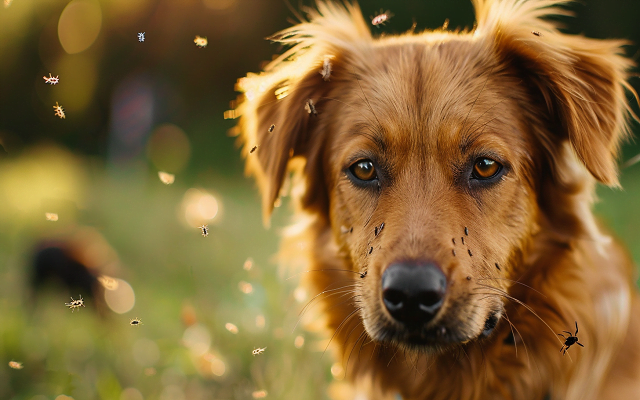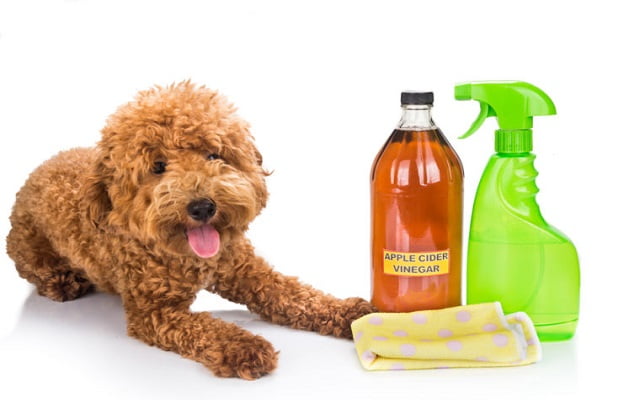It was a warm summer evening, and my Golden Retriever, Buddy, was scratching incessantly. At first, I dismissed it as a minor itch, but as the night progressed, Buddy’s discomfort escalated into frantic scratching and biting. A closer look revealed the culprits – tiny, dark specks hopping around his fur. Fleas had invaded our home! If you’ve ever experienced the frustration of a flea infestation, you know how quickly these tiny pests can turn your furry friend’s life (and yours) upside down.
Fleas aren’t just a nuisance; they can transmit diseases, cause skin allergies, and even lead to anemia in severe cases. While conventional flea treatments exist, many pet owners are seeking safer, natural alternatives that are gentle on their dogs and the environment. The good news is that you don’t have to resort to harsh chemicals to win the war against fleas. In this comprehensive guide, we’ll delve into the world of home remedies for fleas, exploring effective, vet-approved options that can help you reclaim your home and restore your dog’s peace of mind.
Understanding Fleas: The Enemy at the Gate
Before we dive into the arsenal of home remedies, let’s get to know our enemy a little better. Understanding the flea life cycle is crucial for effective control, as it allows you to target these pests at every stage of their development.
The Life Cycle of a Flea
- Eggs: Adult fleas lay tiny, white eggs on your dog’s fur. These eggs easily fall off into the environment, landing on carpets, bedding, and furniture.
- Larvae: Within a few days, the eggs hatch into larvae, which resemble tiny worms. These larvae feed on organic debris, including flea dirt (adult flea feces).
- Pupae: After feeding, the larvae spin cocoons and enter the pupa stage. This stage is the most difficult to eradicate, as pupae are resistant to many insecticides and can remain dormant for months.
- Adults: Finally, adult fleas emerge from the cocoons, ready to feast on your dog’s blood and start the cycle anew.
The Health Risks of Fleas
Fleas are more than just a source of irritation for your dog; they pose several health risks:
- Skin Irritation and Allergies: Flea saliva is a major allergen for dogs, leading to intense itching, redness, and skin infections.
- Anemia: In severe infestations, especially in puppies or small dogs, fleas can consume enough blood to cause anemia (low red blood cell count).
- Tapeworms: Fleas can carry tapeworm larvae, which can infect your dog if they accidentally ingest a flea while grooming.
- Disease Transmission: In rare cases, fleas can transmit diseases like murine typhus to both pets and humans.
Common Misconceptions about Fleas
- Myth: Fleas only infest dirty dogs.
- Fact: Fleas are equal opportunity pests and can infest even the cleanest dogs.
- Myth: Indoor dogs are immune to fleas.
- Fact: Fleas can easily hitch a ride on your clothing or shoes, bringing them into your home.
- Myth: Fleas disappear in winter.
- Fact: Fleas can survive and thrive indoors throughout the year, thanks to the warm temperatures and humidity.
Understanding these facts and dispelling common myths is essential for effective flea control. In the next section, we’ll discuss how to spot the signs of a flea infestation so you can take action before it gets out of hand.
Spotting the Signs: Is Your Dog Hosting Unwanted Guests?
Early detection is key when dealing with fleas. Knowing the visual and behavioral clues can help you nip a potential infestation in the bud before it becomes a full-blown problem.

Visual Clues: What Do Fleas Look Like?
Adult fleas are tiny, dark-colored insects about the size of a sesame seed. They are wingless but incredibly agile, making them difficult to catch with your bare hands. Their bodies are flattened sideways, allowing them to move easily through fur.
One telltale sign of fleas is the presence of “flea dirt.” This is actually flea feces, which looks like tiny black specks resembling ground pepper. To confirm if it’s flea dirt, place the specks on a damp paper towel. If they turn reddish-brown, it’s a sign that they contain digested blood, confirming the presence of fleas.
Behavioral Clues: Your Dog’s Silent Signals
Your dog’s behavior can offer valuable clues about a flea infestation:
- Excessive Scratching, Biting, or Licking: This is the most common sign. If you notice your dog scratching, biting, or licking themselves more than usual, especially around the base of the tail, neck, and belly, it’s worth investigating further.
- Restlessness and Agitation: Fleas can make your dog incredibly uncomfortable, leading to restlessness, pacing, and difficulty sleeping.
- Hair Loss: In severe cases, constant scratching and biting can lead to hair loss, often in patches.
- Pale Gums: Fleas can cause anemia in severe infestations, resulting in pale gums. If you notice this, it’s crucial to seek veterinary attention immediately.
Flea Allergy Dermatitis (FAD): More Than Just an Itch
Some dogs are particularly sensitive to flea saliva and develop an allergic reaction called flea allergy dermatitis (FAD). This condition can cause intense itching, hair loss, and skin infections. Even a single flea bite can trigger a severe reaction in dogs with FAD.
If you suspect your dog has FAD or is experiencing any of the signs mentioned above, it’s essential to take action promptly. The sooner you address a flea infestation, the easier it will be to control and prevent further discomfort for your furry friend.
Preventing the Invasion: A Proactive Approach
The best way to deal with fleas is to prevent them from setting up camp on your dog in the first place. Thankfully, several natural deterrents and environmental management strategies can make your home less inviting to these pesky parasites.

Natural Deterrents: Nature’s Arsenal Against Fleas
Mother Nature provides a bounty of ingredients that fleas find repulsive. Here are some natural deterrents you can use to protect your dog:
- Essential Oils: Certain essential oils, such as lavender, cedarwood, citronella, lemongrass, and peppermint, have flea-repelling properties. You can dilute these oils in water and use them as a spray for your dog’s fur or bedding.
- Diatomaceous Earth (DE): This natural powder, made from fossilized diatoms, works by dehydrating fleas and their larvae. You can sprinkle food-grade DE on your dog’s fur, carpets, and bedding. Be sure to wear a mask when applying DE to avoid inhaling the fine particles.
- Flea-Repelling Plants: Certain plants, such as rosemary, mint, lavender, and chrysanthemums, can help deter fleas. You can plant them in your garden or place them in pots around your home.
Environment Management: Making Your Home a Flea-Free Zone
Keeping your home clean and well-maintained is crucial for flea prevention. Here’s what you can do:
- Wash Bedding Regularly: Fleas love to lay eggs in bedding, so it’s essential to wash your dog’s bedding (and your own) in hot water at least once a week.
- Vacuum Frequently: Vacuum your carpets, floors, and furniture regularly, paying special attention to areas where your dog spends the most time. Dispose of the vacuum bag or canister contents immediately to prevent fleas from escaping.
- Steam Clean Carpets and Upholstery: If you have a steam cleaner, use it to deep clean your carpets and upholstery. The high heat will kill fleas and their eggs.
Year-Round Protection: Don’t Let Your Guard Down
Even in colder months, it’s important to remain vigilant about flea prevention. Fleas can survive indoors year-round, thanks to central heating and humidity. Continue using natural deterrents and maintaining a clean environment to keep your dog flea-free throughout the year.
In the next section, we’ll delve into specific home remedies for fleas, exploring what works, what doesn’t, and how to use them safely and effectively.
Home Remedies for Fleas: What Works, What Doesn’t
Now that we’ve covered prevention, let’s explore the world of home remedies for fleas. While these remedies can be effective, it’s important to use them safely and understand their limitations.

Apple Cider Vinegar (ACV): The Acid Test
Apple cider vinegar (ACV) is a popular home remedy for fleas, thanks to its acidic nature. Fleas dislike the taste and smell of ACV, making it a natural deterrent. Here are a few ways to use ACV for flea control:
- Flea-Repellent Spray: Mix equal parts ACV and water in a spray bottle. Spray your dog’s fur lightly, avoiding the eyes, nose, and mouth. You can also spray the solution on bedding, carpets, and furniture.
- ACV Rinse: After shampooing your dog, rinse their fur with a solution of 1 cup ACV to 1 gallon of water. This can help repel fleas and leave their coat shiny.
- Oral ACV: Some pet owners add a small amount of ACV (1 teaspoon per 50 pounds of body weight) to their dog’s water bowl. However, consult your veterinarian before giving ACV orally, as it may not be suitable for all dogs.
Pros of ACV:
- Natural and non-toxic
- Can help repel fleas and soothe irritated skin
- May improve coat health
Cons of ACV:
- Not a standalone solution for flea infestations
- May not be suitable for dogs with sensitive skin or digestive issues
- Can have a strong smell
Citrus Power: Unleashing the Zest
Citrus fruits like lemons and oranges contain compounds that fleas find unpleasant. Here’s how you can harness their power:
- Lemon Juice Spray: Boil sliced lemons in water, let the solution cool, and strain it. Pour the lemon-infused water into a spray bottle and apply it to your dog’s fur.
- Orange Peel Rub: Rubbing orange peels on your dog’s fur can help repel fleas. However, be careful not to let your dog ingest the peels, as they can cause digestive upset.
Pros of Citrus Remedies:
- Natural and readily available
- May help repel fleas
Cons of Citrus Remedies:
- Not a strong enough deterrent for severe infestations
- Can be irritating to some dogs’ skin
- Citrus oils can be toxic to pets if ingested in large amounts.
Herbal Allies: Nature’s Flea-Fighting Arsenal
Several herbs have been used for centuries to repel fleas. Here are a few worth exploring:
- Rosemary: This aromatic herb can be used as a rinse or infused in oil to repel fleas.
- Lavender: Lavender oil has calming and flea-repelling properties. You can dilute it in water and spray it on your dog’s fur.
- Neem: Neem oil is a natural insecticide that can help control fleas. It can be applied to your dog’s fur or added to their shampoo.
Pros of Herbal Remedies:
- Natural and often safe for pets
- Can help repel fleas and soothe irritated skin
Cons of Herbal Remedies:
- May not be effective for severe infestations
- Some herbs can be toxic to pets if ingested in large amounts. Always consult with your veterinarian before using herbal remedies on your dog.
The Salt Solution: Dessication Destination
Salt might be a staple in your kitchen, but it can also be a weapon against fleas. Salt works by dehydrating flea eggs and larvae, disrupting their life cycle. Here’s how to utilize salt’s power:
- Salt Bath: Dissolve 1 cup of salt in a tub of warm water. Ensure the water is deep enough to cover your dog’s belly. Let your dog soak for a few minutes, then rinse them thoroughly with fresh water.
- Salt Scrub: Combine salt with a small amount of warm water to create a paste. Gently massage the paste into your dog’s fur, focusing on areas where fleas are most likely to congregate. Leave the paste on for a few minutes, then rinse thoroughly.
Pros of Salt:
- Natural and readily available
- Can help kill flea eggs and larvae
Cons of Salt:
- Can be drying to your dog’s skin, so use it sparingly.
- Not effective against adult fleas
- Avoid getting salt in your dog’s eyes
The Coconut Oil Conundrum: Miracle Cure or Myth?
Coconut oil has gained popularity as a natural flea repellent, but the evidence for its effectiveness is mixed. Some studies suggest that coconut oil can suffocate and repel some fleas, while others have found it to be less effective.
Potential Benefits of Coconut Oil:
- Soothes irritated skin and promotes healing
- May repel some fleas due to its lauric acid content
- Conditions and adds shine to your dog’s coat
Limitations of Coconut Oil:
- Not a reliable standalone treatment for flea infestations
- Can make your dog’s fur greasy
- May not be suitable for dogs prone to oily skin
If you choose to use coconut oil, apply a small amount to your dog’s fur, working it in thoroughly. Avoid the eyes and nose.
Unique Angle: Flea-Fighting Foods
Believe it or not, some foods can make your dog less appealing to fleas. While not a substitute for traditional flea control methods, incorporating these foods into your dog’s diet could offer an extra layer of protection.

Brewer’s Yeast: The B-Vitamin Booster
Brewer’s yeast is a nutritional powerhouse packed with B vitamins. These vitamins can alter your dog’s scent, making them less attractive to fleas. You can sprinkle brewer’s yeast on your dog’s food or offer it as a treat.
Garlic: The Pungent Protector
Garlic contains sulfur compounds that some believe have flea-repelling properties. However, it’s crucial to use garlic cautiously, as it can be toxic to dogs in large amounts. Consult your veterinarian before adding garlic to your dog’s diet and always use it in moderation.
Apple Cider Vinegar in Diet: A Tangy Twist
As mentioned earlier, apple cider vinegar can help deter fleas. Some pet owners add a small amount of ACV (1 teaspoon per 50 pounds of body weight) to their dog’s water bowl. However, always consult your veterinarian before adding ACV to your dog’s diet, as it may not be suitable for all dogs.
Remember, these foods are not miracle cures for fleas, but they can be a helpful addition to your overall flea control strategy.
When to Seek Professional Help
While home remedies can be effective for mild flea infestations, there are situations where professional intervention is necessary.
Severe Infestations: A Losing Battle?
If your dog has a severe flea infestation that doesn’t seem to improve with home remedies, it’s time to consult your veterinarian. They can prescribe stronger flea medications that can quickly eliminate the infestation and provide relief for your dog.
Flea Allergies: Beyond Itching
If your dog develops an allergic reaction to fleas (FAD), home remedies may not be enough to manage their symptoms. Veterinary care is essential to diagnose FAD, provide relief from itching and inflammation, and prevent secondary skin infections.
Conclusion
Taking control of your dog’s flea problem doesn’t have to be a toxic ordeal. With a combination of preventative measures and natural home remedies, you can create a safe haven for your furry friend—one that’s inhospitable to those pesky fleas. Remember, a multi-pronged approach is key. Utilize natural deterrents like essential oils, diatomaceous earth, and flea-repelling plants, maintain a clean environment, and explore the flea-fighting potential of certain foods.
Don’t hesitate to experiment with different home remedies to see what works best for your dog. If you encounter a severe infestation or your dog develops a flea allergy, don’t hesitate to seek professional veterinary care. Remember, you’re not alone in this battle. Share your experiences with other dog owners, ask questions, and together, we can create a world where fleas are a thing of the past.
So, are you ready to take the reins and reclaim your home from those pesky fleas? Your dog (and your sanity) will thank you!
I hope this comprehensive guide proves to be a valuable resource for you in your quest for a flea-free home. If you have any questions or would like me to elaborate on any aspect, feel free to ask!
FAQ: Your Burning Questions About Home Remedies for Fleas on Dogs
Can I combine multiple home remedies for fleas on my dog for better results?
Absolutely! Combining different home remedies can often enhance their effectiveness. For example, you could start with a soothing oatmeal bath to relieve itching, followed by an apple cider vinegar rinse to deter fleas, and then apply a diluted essential oil spray for added protection. However, it’s important to be cautious and avoid any combinations that could irritate your dog’s skin. Always introduce new remedies gradually and monitor your dog for any adverse reactions.
Are there specific home remedies that are safer for puppies or senior dogs with sensitive skin?
Yes, certain home remedies are gentler and more suitable for puppies and senior dogs with delicate skin. Oatmeal baths are a great option, as they soothe irritated skin and can help remove fleas. Diluted apple cider vinegar rinses (1 part ACV to 10 parts water) can also be gentle on sensitive skin. Always consult your veterinarian before using any new remedy on your dog, especially if they have any underlying health conditions.
What are the early warning signs that home remedies aren’t working, and it’s time to see a vet?
While home remedies can be effective for mild flea infestations, it’s crucial to recognize when they’re not enough. If your dog’s itching and scratching worsen despite using home remedies, or if you notice hair loss, scabs, or signs of infection, it’s time to consult your veterinarian. Additionally, if your dog develops an allergic reaction to fleas (FAD), professional intervention is necessary.
Can a change in my dog’s diet truly help repel fleas, and if so, what foods should I focus on?
While diet alone won’t eliminate fleas, certain foods can make your dog less appealing to them. Brewer’s yeast, rich in B vitamins, can alter your dog’s scent and make them less attractive to fleas. Garlic, in moderation and with veterinary guidance, may also have flea-repelling properties. However, it’s crucial to remember that dietary changes are just one part of a comprehensive flea control strategy.
How often should I apply home remedies to my dog for ongoing flea prevention?
The frequency of application depends on the specific remedy and the severity of the flea infestation. For example, you might apply a flea-repelling spray daily during peak flea season, but only weekly during colder months. Bathing your dog with a flea-repelling shampoo should be done no more than once a week to avoid drying out their skin. Always follow the instructions for each remedy and consult your veterinarian if you have any questions.

Healthy dogs mean happy dogs, and that makes me happy! I’m here to share all the tips for keeping your best furry friend in top shape, from puppyhood to their golden years.

